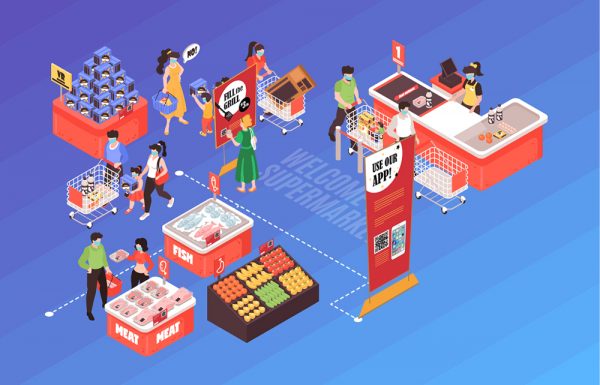5 Reasons In-Store Signage Is More Important Than Ever

The best brick-and-mortar stores have always prided themselves on giving consumers reasons to return. Retailers are leaning into in-store signage as a key strategy to engage today’s shoppers, along with store design and layout to product selection, and customer service. It’s about creating an experience that surprises and delights enough to drive return visits.
With reduced budgets and staffing, smart retailers are turning to in-store signage to act as their “silent salesperson.” Not only can it inform shoppers about conveniences like curbside pickup, but it can also engage with fun and entertaining marketing campaigns, while helping compel consumers to make purchases and buy cross-sells. From big-box stores to grocery chains, in-store signage has become front and center as a retail strategy to connect with consumers. And today’s shoppers include the researchers, the bargain hunters, and customers on a mission, according to SmartOSC, making savvy marketing all the more important.
As stores and shoppers continue to deal with a climate of economic uncertainty, Medallion Retail has identified five points where retail signage can help merchants connect with consumers who are feeling reluctant, yet still searching for the types of haptic experiences they connect with best.
1. Help Shoppers Find What They’re Looking for And What They Didn’t Know They Needed.
Shoppers don’t like a change in a store layout. Whether shifting product around or pushing overstocked merchandise from earlier in the year to a higher-trafficked area, they find change in a store annoying. Being creatures of habit, customers don’t like hunting for pasta that used to be near the tomato sauce. In-store signage can help alleviate some of that stress and annoyance by informing shoppers of the changes in layout and telling them where to look for relocated items.
These days, there are also plenty of shoppers who are strapped for time and looking to shorten the in-store experience. To help them quickly find components for a home-cooked dinner for two or a household DIY project, signage can provide useful ideas and suggestions, along with add-ins not originally contemplated. Placed adjacent to other popular products, signage gives shoppers an immediate reference to items that may not have originally even been on their shopping list.
2. Retail Signage Strategies: Demonstrate What the Packaging Does Not.
Retail signage provides explanations or can demonstrate a product’s attributes, uses, benefits, and more. Signage can also motivate the shopper to explore more and linger longer. In-store apps connect the browsing consumer with their sought-after product, but then they may have to sift through online inventory to find it. A faster and easier solution might be QR codes used in signage or shelf talkers. This approach can quickly provide the shopper with immediate education on the product without having to search for it or remove the product from the shelf.
According to TouchPoints, QR codes are a boon to retailers and CPG brands with products sold in brick-and-mortar stores, who can offer a wider selection of products by pointing consumers online when browsing in-store. QR codes have become essential to QR code retail marketing, connecting shoppers to digital offers, videos, and brand stories.
3. Promote Both In Store and Online
Grocery stores are following the lead of retail food delivery giants Walmart and Amazon, and leaning into digital ordering capabilities with expanded backrooms for assembling same-day orders, as well as automation for when order volume is high.
As backrooms enlarge and buy online/pick up in store (BOPIS) continues to grow, brand/product selection may be defined purely by SKU demand. This means the selling floor may shrink. But in-store signage could allow consumers to order what they want through online inventory, as well as provide links to help them easily start the process.
4. Quickly Pivot Your Offerings
The “silent salesperson,” aka signage, is not limited to retail. In food service, in-store signage can actually stand in for those menus posted in restaurant windows, as well as tableside.
“From menus to marketing, QR Codes have quietly become one of the most impactful tools in modern restaurant operations,” notes Bitly. “What started as a quick fix during the pandemic has evolved into a core part of restaurant marketing strategies, streamlining everything from contactless ordering to customer feedback and loyalty.” Some of the most effective places to post these now-essential marketing tools are in-store signage and displays, including table tents, tabletop inserts, posters, and sandwich boards.
5. Surprise. Delight. Entertain. Reward.
In-store signage is generally meant to connect retailers and brands with customers, yet these shoppers often have family in tow. These tagalongs have been disrupting shopping trips for generations of parents. However, signage that sports downloadable QR codes can give family members something to interact with while others shop. In-store signage provides the perfect platform for scannable games, contests, and scavenger hunts that can reward players at checkout or incentivize a return visit in the future. For example, Medallion Retail discussed QR codes that would appeal to and engage March Madness fans through games and contests.
Medallion Retail considers QR codes a win-win for merchants, both large and small, because they promote brands while providing data on how many people keyed in on them. They help restaurateurs as much as retailers, who can discover why shoppers looked at signage with a QR code versus a one-dimensional print. Businesses who use these codes are going to spend less on their advertising, know more about their customer, and then have the ability to provide multiple choices for ads in one code.
Whether to connect with customers in new ways or help sell products where it might otherwise be lost in the fray, signage is truly coming of age as a silent salesperson. Ready to make the most of in-store signage opportunities for your brand or retailer? Contact Medallion Retail today.